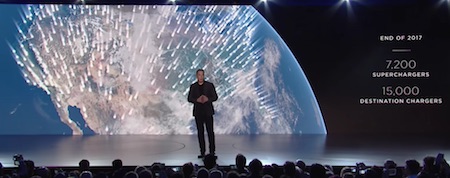Science Fiction
Dictionary
A B C D E F G H I J K L M N O P Q R S T U V W X Y Z
Tesla Unveils Affordable Model 3 Electric Car

Last night, Elon Musk of Tesla Motors unveiled the Model 3, Tesla's affordable electric car. Not an April Fool's joke, this reasonably-priced sedan can carry us to a sustainable future.
(Tesla Unveils Affordable Model 3 Electric Car)
Take a look at this short test ride:
(Short test ride in Tesla Model 3 Electric Car)
Science fiction writers did not create the idea of electric cars; electric vehicles of different types (2,3 and 4 wheels) were in use in Europe in the late 19th century. Electric vehicles also had a brief vogue with well-to-do buyers in large cities, who weren't bothered by their relatively short range, considering it a reasonable trade-off for quiet, odor-free operation.
In his 1894 novel A Journey in Other Worlds, however, John Jacob Astor IV painted the following utopian picture of a transportation system that used electric phaetons which may seem quaint today, particularly given the speed and handling characteristics of the Tesla Model S:
"The electric phaetons, as those for high speed are called, have three and four wheels, and weigh, including battery and motor, five hundred to four thousand pounds. With hollow but immensely strong galvanically treated aluminum frames and pneumatic or cushion tires, they run at thirty-five and forty miles an hour on country roads, and attain a speed over forty on city streets, and can maintain this rate without recharging for several days. They can therefore roam over the roads of the entire hemisphere, from the fertile valley of the Peace and grey shores of Hudson Bay, to beautiful Lake Nicaragua, the River Plate, and Patagonia, improving man by bringing him close to Nature, while they combine the sensations of coasting with the interest of seeing the country well..."...we feel that `Excelsior!' is indeed our motto."
You'll note that Elon Musk spent a fair amount of time describing the network of recharging stations that make electric cars a reality.

(Tesla superchargers next year)
John Jacob Astor also covered this requirement:
"To recharge the batteries, which can be done in almost every town and village, two copper pins attached to insulated copper wires are shoved into smooth-bored holes. These drop out of themselves by fusing a small lead ribbon, owing to the increased resistance, when the acid in the batteries begins to 'boil,' though there is, of course, but little heat in this, the function of charging being merely to bring about the condition in which part of the limestone can be consumed, the batteries themselves, when in constant use, requiring to be renewed about once a month.
(Read more about the Electric Car Recharging Station)
Scroll down for more stories in the same category. (Story submitted 4/1/2016)
Follow this kind of news @Technovelgy.| Email | RSS | Blog It | Stumble | del.icio.us | Digg | Reddit |
Would
you like to contribute a story tip?
It's easy:
Get the URL of the story, and the related sf author, and add
it here.
Comment/Join discussion ( 0 )
Related News Stories - (" Vehicle ")
The 'Last Mile' In China Crowded With Delivery Robots
Yes, it's a delivery robot. On wheels.
Musk Idea Of Cars Talking To Each Other Predicted 70 Years Ago
'My cars talk to one another.' - Isaac Asimov, 1953.
Waymo And Tesla 'Autonomous Cabs' Are Piloted By Remote Drivers
‘Where to, sport?’ the starter at cab relay asked. - Philip K. Dick, 1957.
Maybe It's Too Soon To Require Autonomous Mode
'I hope all those other cars are on automatic,' he said anxiously. - Arthur C. Clarke, 1976.
Technovelgy (that's tech-novel-gee!) is devoted to the creative science inventions and ideas of sf authors. Look for the Invention Category that interests you, the Glossary, the Invention Timeline, or see what's New.
Science Fiction
Timeline
1600-1899
1900-1939
1940's 1950's
1960's 1970's
1980's 1990's
2000's 2010's
Current News
The Zapata Air Scooter Would Be Great In A Science Fiction Story
'Betty's slapdash style.'
Thermostabilized Wet Meat Product (NASA Prototype)
There are no orbiting Michelin stars. Yet.
Could Crystal Batteries Generate Power For Centuries?
'Power could be compressed thus into an inch-square cube of what looked like blue-white ice'
India Ponders Always-On Smartphone Location Tracking
'It is necessary... for your own protection.'
Amazon Will Send You Heinlein's Knockdown Cabin
'It's so light that you can set it up in five minutes by yourself...'
Is It Time To Forbid Human Driving?
'Heavy penalties... were to be applied to any one found driving manually-controlled machines.'
Replace The Smartphone With A Connected Edge Node For AI Inference
'Buy a Little Dingbat... electropen, wrist watch, pocketphone, pocket radio, billfold ... all in one.'
Artificial Skin For Robots Is Coming Right Along
'... an elastic, tinted material that had all the feel and appearance of human flesh and epidermis.'
Robot Guard Dog On Duty
I might also be thinking of K-9 from Doctor Who.
Wearable Artificial Fabric Muscles
'It is remarkable that the long leverages of their machines are in most cases actuated by a sort of sham musculature...'
BrainBridge Concept Transplant Of Human Head Proposed
'Briquet’s head seemed to think that to find and attach a new body to her head was as easy as to fit and sew a new dress.'
Google's Nano Banana Pro Presents Handwritten Math Solutions
'...copy was turned out in a charming and entirely feminine handwriting.'
Edible Meat-Like Fungus Like Barbara Hambly's Slunch?
'It was almost unheard of for slunch to spread that fast...'
Sunday Robotics 'Memo' Bot Has Unique Training Glove
'He then started hand movements of definite pattern...'
Woman Marries Computer, Vonnegut's Dream Comes True
'Men are made of protoplasm... Lasts forever.'
Natural Gait With Prosthetic Connected To Nervous System
'The leg was to function, in a way, as a servo-mechanism operated by Larry’s brain...'
